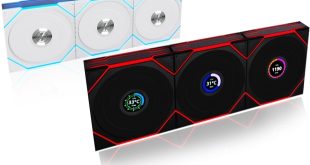We have changed our method of measuring noise levels. We have built a system inside a Lian Li chassis with no case fans and have used a fanless cooler on our CPU. We are using a heatpipe based passive power supply and an Intel SSD to keep noise levels to a minimum. The motherboard is also passively cooled. This gives us a build with completely passive cooling and it means we can measure noise of just the graphics card inside the system when we run looped 3dMark tests.
Ambient noise in the room is around 20-25dBa. We measure from a distance of around 1 meter from the closed chassis and 4 foot from the ground to mirror a real world situation.
Why do this? Well this means we can eliminate secondary noise pollution in the test room and concentrate on only the video card. It also brings us slightly closer to industry standards, such as DIN 45635.
KitGuru noise guide
10dBA – Normal Breathing/Rustling Leaves
20-25dBA – Whisper
30dBA – High Quality Computer fan
40dBA – A Bubbling Brook, or a Refridgerator
50dBA – Normal Conversation
60dBA – Laughter
70dBA – Vacuum Cleaner or Hairdryer
80dBA – City Traffic or a Garbage Disposal
90dBA – Motorcycle or Lawnmower
100dBA – MP3 player at maximum output
110dBA – Orchestra
120dBA – Front row rock concert/Jet Engine
130dBA – Threshold of Pain
140dBA – Military Jet takeoff/Gunshot (close range)
160dBA – Instant Perforation of eardrum
The reference card generates more noise than the MSI R7770 Power Edition, noticeable under load. The extra fan adds very little to the overall noise emissions. We would run this graphics card in dual fan mode all the time, unless constrained by physical space, such as when inside a small HTPC chassis.
 KitGuru KitGuru.net – Tech News | Hardware News | Hardware Reviews | IOS | Mobile | Gaming | Graphics Cards
KitGuru KitGuru.net – Tech News | Hardware News | Hardware Reviews | IOS | Mobile | Gaming | Graphics Cards




Dont get it… you either want a single fan card, or a dual fan card…so just buy a single fan card, or a dual fan card- there are better dual fan coolers out there, such as XFXs Brushed Aluminium cooler, looks a thousand times better than the neon blue plastic tat on this card… Its not like your going to put this in your system and suddenly wake up one day and say- ‘i know i fancy two fans today’….
I get your point, although I think its cool you can basically change the noise/cooling balance to suit different environments. size too.
If it cost £30 more then its pretty pointless, but it seems closely priced to the other HD7770s.
Still think sapphire HD6850 was the best deal for a while at £90.
Great motherboard but im not sure on the graphics card. its clever, but for the target market im not sure its a buying decision. You either want a smaller card for a media center, or a higher cooled, size card for gaming.
Gamers wont buy the HD7770 I wouldnt think, so why not just put a larger single fan on the HD7770 in the first place and ditch the extra fan completely?
Nice idea to be creative like this, but ultimately I think its a bit pointless.
Ok, first thing first. this motherboard is from what I know the same as the GD65 but now has thunderbolt. its a great board. all we need to say (apart from the added price for thunderbolt).
The graphics card is frigging cool. The shiftable cooler idea is nice. Its maybe only useful for people who change systems regularly. so you could ditch a fan, slot it into a HPTC, then take it out, extend it then add another etc.
How many people would do that though? Might make more sense on a HD7850 or 7870. HD7770 is more suited just for media duties and low powered use.
please put two hd7770 in crossfire the results will show that they can deliver more fps
than the high end gtx 670 and hd 7870
with lots of money left over get that new motherboard
give it try